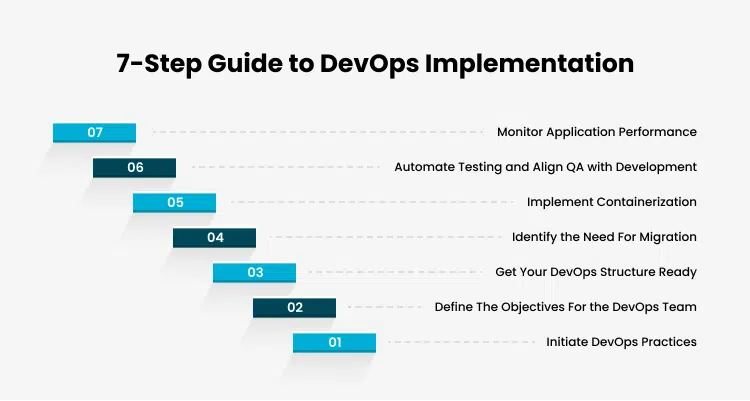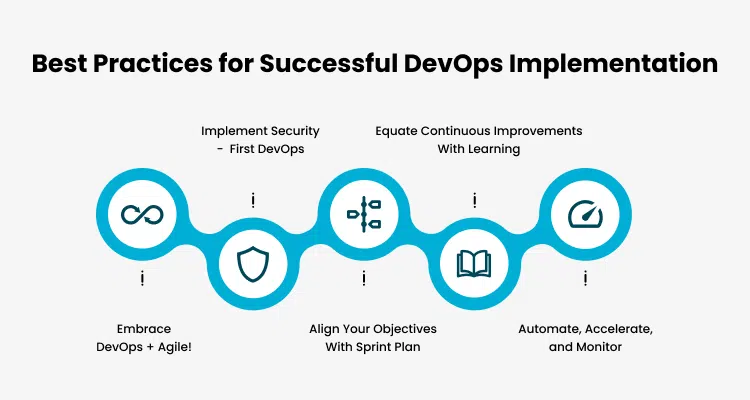According to Google Cloud, DevOps has the highest impact on software delivery performance. This means DevOps is the final block to solving your software delivery puzzle.
You need strategic planning, proper execution, and best practices to maximize DevOps implementations.

What is DevOps, and Why is it Important?
DevOps is a set of practices that bridge development and operations teams for faster, more efficient, and streamlined software development.
1. Understanding the Basics of DevOps
For example, you can integrate the security and QA teams with the development and operations teams to leverage DevSecOps.
Embracing the DevOps culture will result in merging teams and adopting tech stacks and tools that improve software development efficiency.
Why is DevOps Implementation Important?
In a conventional software development process, collaborations are challenged.
1. Benefits of DevOps Implementation
The value of DevOps lies in the increased focus on developing cross-functional skills and faster software delivery.
1.1 Organizational Stability
Improve collaborations through a gamification approach, where team members are encouraged to perform cross-functional tasks. Improve QA, testing automation, staging, and more.
1.2 Quicker Time-to-Market
DevOps implementation can reduce the time to market, helping you gain a competitive edge. Enterprises have strategic product launches to gain first-mover advantage.
However, conventional development approaches can be detrimental to such strategies..
Implementing DevOps allows you to streamline development and rapidly build software. This can be helpful even for startups looking to take advantage by quickly bringing their ideas to market.
1.3 Improved Product Quality
You can implement DevSecOps practices to ensure product security. Increased security and an error-free experience can also contribute to customer satisfaction.
1.4 Accelerated Time-to-Resolution
1.5 Dynamic Task Management
Planning to Implement Devops?
Contact us today and let our team of experienced professionals transform your vision into an innovative and user-friendly app that stands out in the market!
What are the Key Steps in a DevOps Implementation Plan?
1. Initiate the Introduction of DevOps
2. Identify The Need For DevOps
3. Define Key Roles And Responsibilities
Once you identify the key areas of DevOps implementations, you must determine critical roles that will play an active role.
For example, you need to define teams that will be unified to form a DevOps team. Plus, you can hire DevOps consultants or DevOps management services for better planning.
4. Creating a DevOps Implementation Strategies
Most commonly, dedicated managers assigned to the implementation process design DevOps strategies. These strategies are focused on two common goals,
- Supporting the process of continuous software releases
- Enabling teams with efficiency and productivity through enhanced collaborations.
5. Choosing the Right DevOps Tools for Your Organization
- Establish essential functionalities to lay the DevOps groundwork with tools like Git, Jenkins, and Spinnaker. Here, Git is used for version control, Jenkins is used for continuous integration, and Spinnaker is used for continuous delivery.
- Use Ansible for configuration management and efficient control of your infrastructure.
- Containerize your applications with the Docker and Kubernetes packages.
- Optimize the performance of your applications leveraging DevOps tools like Datadog or Dynatrace.
- Automate testing using Selenium and security testing tools like StackRox.
6. Developing a DevOps Implementation Roadmap
7-Step Guide to DevOps Implementation

1. Initiate DevOps Practices
2. Define The Objectives For the DevOps Team
First, you must ensure the software quality and delivery expectations are set. Communicate key objectives regarding the software quality you want to deliver through DevOps implementations.
Next, and one of the most important aspects of defining the objectives, is establishing KPIs.
This allows your DevOps teams to measure the system’s performance and identify critical bottlenecks.
3. Get Your DevOps Structure Ready
The DevOps team structure can have dedicated team members working on CI/Cd implementations.
4. Identify the Need For Migration
5. Implement Containerization
- Break down your app into smaller parts—Split your app into smaller services. Put each one in a container with what it needs to work well. This ensures that it always runs smoothly. Set up automatic systems for building, testing, and deploying apps.
- Set up container management- Use a tool like Kubernetes to handle and grow applications.
- Keep it safe and follow the rules- Use innovative safety steps like checking images and dividing up the system.
- Keep an eye on containers- Use tools to monitor containers, find, and fix problems fast.
- Integrate Infrastructure With CI/CD Tools
- Once you containerize applications, maintaining and managing them becomes crucial. You can leverage CI/CD tools like Jenkins, Bamboo, and GoCD.
6. Automate Testing and Align QA with Development
For example, if you are developing an MVP, QA needs to first check the app’s basic function rather than go all out on testing for user acceptance and other such parameters.
7. Monitor Application Performance
Best Practices for Successful DevOps Implementation

1. Embrace DevOps + Agile!
Embracing the DevOps culture and agile methodology, you can implement an iterative approach.
2. Implement Security-First DevOps
3. Align Your Objectives With Sprint Plan
4. Equate Continuous Improvements With Learning
5. Automate, Accelerate, and Monitor
Want to Automate Your Business Process With a Software Solution?
Zennaxx, a leading software development firm in Canada, has delivered 700+ bespoke solutions spanning various industries.
6. The Future of DevOps: Emerging Tech & Trends
7. Using AI to Streamline DevOps
8. Embrace DevSecOps
9. Leverage FinOps for Cloud Cost Optimization
- Establish cloud governance policies that help reduce costs
- Define KPIs for financial accountability and value realization
- Modernize budgeting, forecasting, and chargeback methods
- Use cloud cost optimization tools for better ROI.
How to Start Your DevOps Journey WIth Zennaxx
You need experts in DevOps implementation to ensure optimal results. This is where Zennaxx can help with a team of DevOps experts. Get an estimate of your DevOps implementation project now.


